2019 NISSAN TITAN steering wheel
[x] Cancel search: steering wheelPage 33 of 682
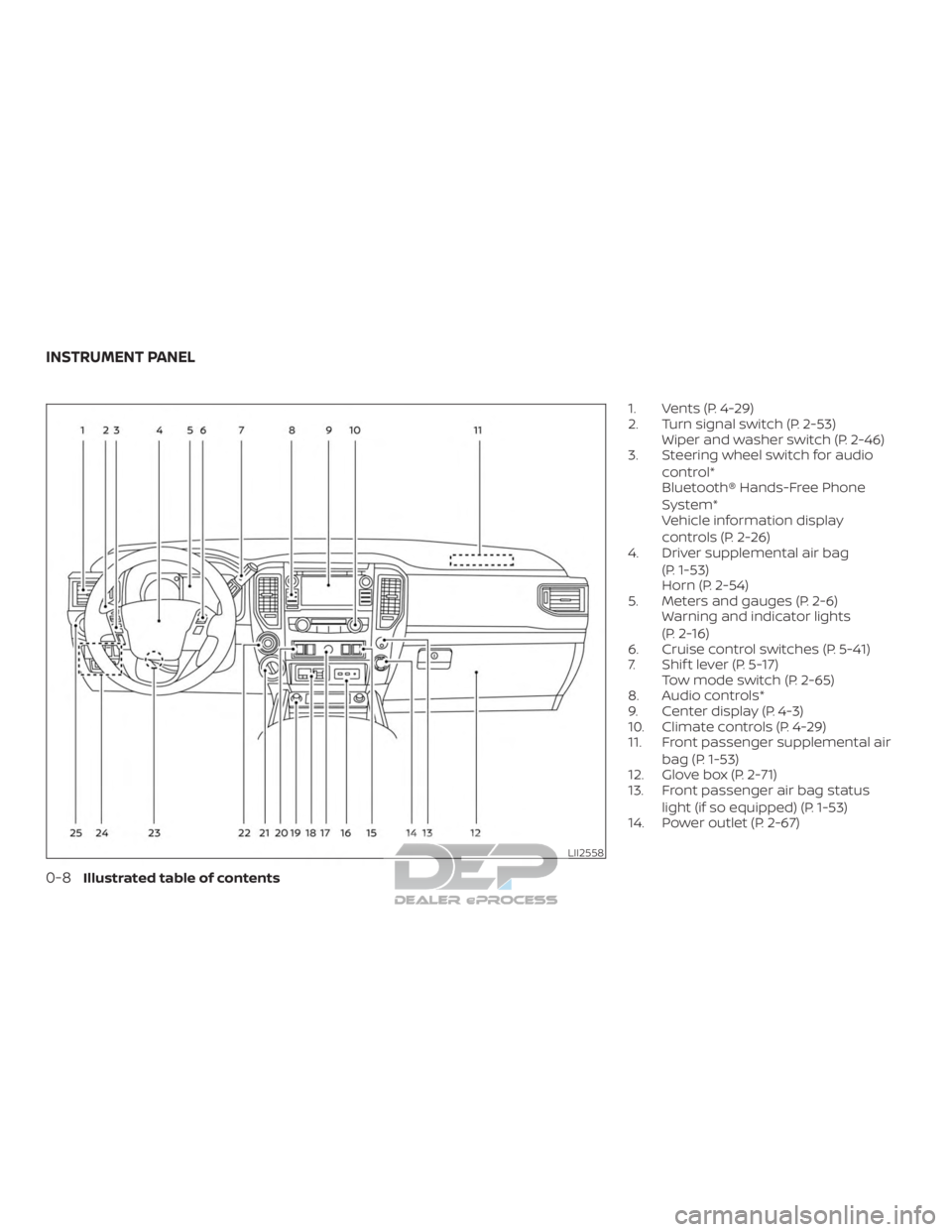
1. Vents (P. 4-29)
2. Turn signal switch (P. 2-53)Wiper and washer switch (P. 2-46)
3. Steering wheel switch for audio
control*
Bluetooth® Hands-Free Phone
System*
Vehicle information display
controls (P. 2-26)
4. Driver supplemental air bag
(P. 1-53)
Horn (P. 2-54)
5. Meters and gauges (P. 2-6) Warning and indicator lights
(P. 2-16)
6. Cruise control switches (P. 5-41)
7. Shif t lever (P. 5-17) Tow mode switch (P. 2-65)
8. Audio controls*
9. Center display (P. 4-3)
10. Climate controls (P. 4-29)
11. Front passenger supplemental air
bag (P. 1-53)
12. Glove box (P. 2-71)
13. Front passenger air bag status
light (if so equipped) (P. 1-53)
14. Power outlet (P. 2-67)
LII2558
INSTRUMENT PANEL
0-8Illustrated table of contents
Page 34 of 682
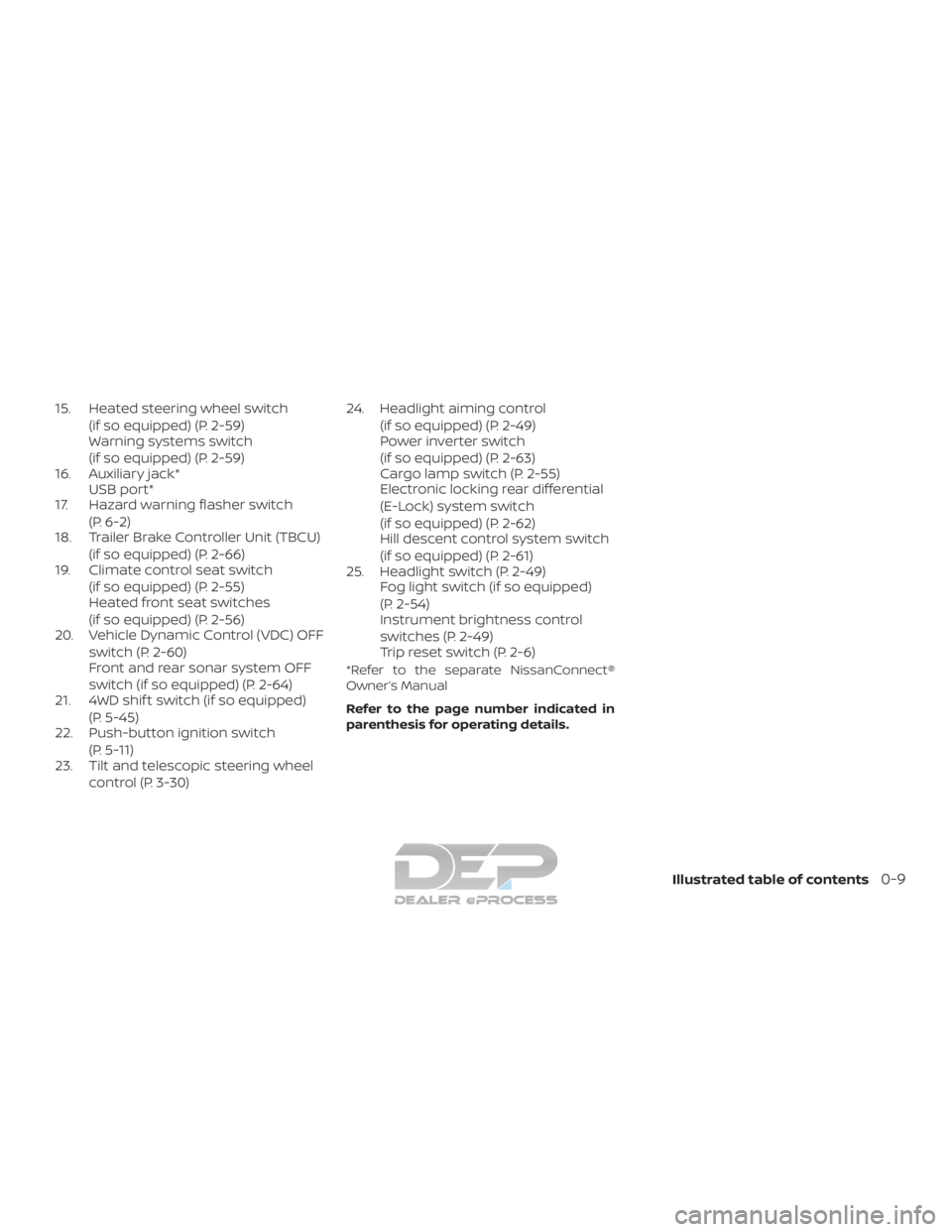
15. Heated steering wheel switch(if so equipped) (P. 2-59)
Warning systems switch
(if so equipped) (P. 2-59)
16. Auxiliary jack* USB port*
17. Hazard warning flasher switch
(P. 6-2)
18. Trailer Brake Controller Unit (TBCU)
(if so equipped) (P. 2-66)
19. Climate control seat switch
(if so equipped) (P. 2-55)
Heated front seat switches
(if so equipped) (P. 2-56)
20. Vehicle Dynamic Control (VDC) OFF
switch (P. 2-60)
Front and rear sonar system OFF
switch (if so equipped) (P. 2-64)
21. 4WD shif t switch (if so equipped)
(P. 5-45)
22. Push-button ignition switch
(P. 5-11)
23. Tilt and telescopic steering wheel
control (P. 3-30) 24. Headlight aiming control
(if so equipped) (P. 2-49)
Power inverter switch
(if so equipped) (P. 2-63)
Cargo lamp switch (P. 2-55)
Electronic locking rear differential
(E-Lock) system switch
(if so equipped) (P. 2-62)
Hill descent control system switch
(if so equipped) (P. 2-61)
25. Headlight switch (P. 2-49) Fog light switch (if so equipped)
(P. 2-54)
Instrument brightness control
switches (P. 2-49)
Trip reset switch (P. 2-6)
*Refer to the separate NissanConnect®
Owner’s Manual
Refer to the page number indicated in
parenthesis for operating details.
Illustrated table of contents0-9
Page 94 of 682

7. If the booster seat is installed in thefront passenger seat, place the ignition
switch in the ON position. The front pas-
senger air bag status light
(if so
equipped) may or may not illuminate,
depending on the size of the child and
the type of booster seat being used. For
additional information, refer to “Front
passenger air bag and status light” in
this section.
PRECAUTIONS ON SRS (with
NISSAN Advanced Air Bag System)
(if so equipped)
This SRS section contains important infor-
mation concerning the following systems:
∙ Driver and front passenger supplemen- tal front-impact air bag (NISSAN Ad-
vanced Air Bag System)
∙ Front seat-mounted side-impact supplemental air bag
∙ Roof-mounted curtain side-impact and rollover supplemental air bag
∙ Seat belt with pretensioner(s) (front seats)
Supplemental front-impact air bag system
The NISSAN Advanced Air Bag System can
help cushion the impact force to the head
and chest of the driver and right front pas-
senger in certain frontal collisions.
Front seat-mounted side-impact
supplemental air bag system
This system can help cushion the impact
force to the chest area of the driver and right
front passenger in certain side impact colli-
sions. The side air bag is designed to inflate
on the side where the vehicle is impacted.
Roof-mounted curtain side-impact and
rollover supplemental air bag system
This system can help cushion the impact
force to the head of occupants in front and
rear outboard seating positions (if so
equipped) in certain side impact or rollover
collisions. In a side impact, the curtain air
bags are designed to inflate on the side
where the vehicle is impacted. In a rollover,
curtain air bags are designed to inflate and
remain inflated for a short time.
The SRS is designed to supplementthe
crash protection provided by the seat belts
and is not a substitute for them. Seat belts
should always be correctly worn and the
occupant seated a suitable distance away
from the steering wheel, instrument panel
and door finishers. For additional informa-
tion, refer to “Seat belts” in this section.
The supplemental air bags operate only
when the ignition switch is in the ON or
START position.
Af ter turning the ignition key to the ON
position, the supplemental air bag warn-
ing light illuminates. The supplemental
air bag warning light will turn off af ter
about 7 seconds if the system is opera-
tional.
WRS0475
SUPPLEMENTAL RESTRAINT SYSTEM
(SRS)
Safety—Seats, seat belts and supplemental restraint system1-53
Page 95 of 682
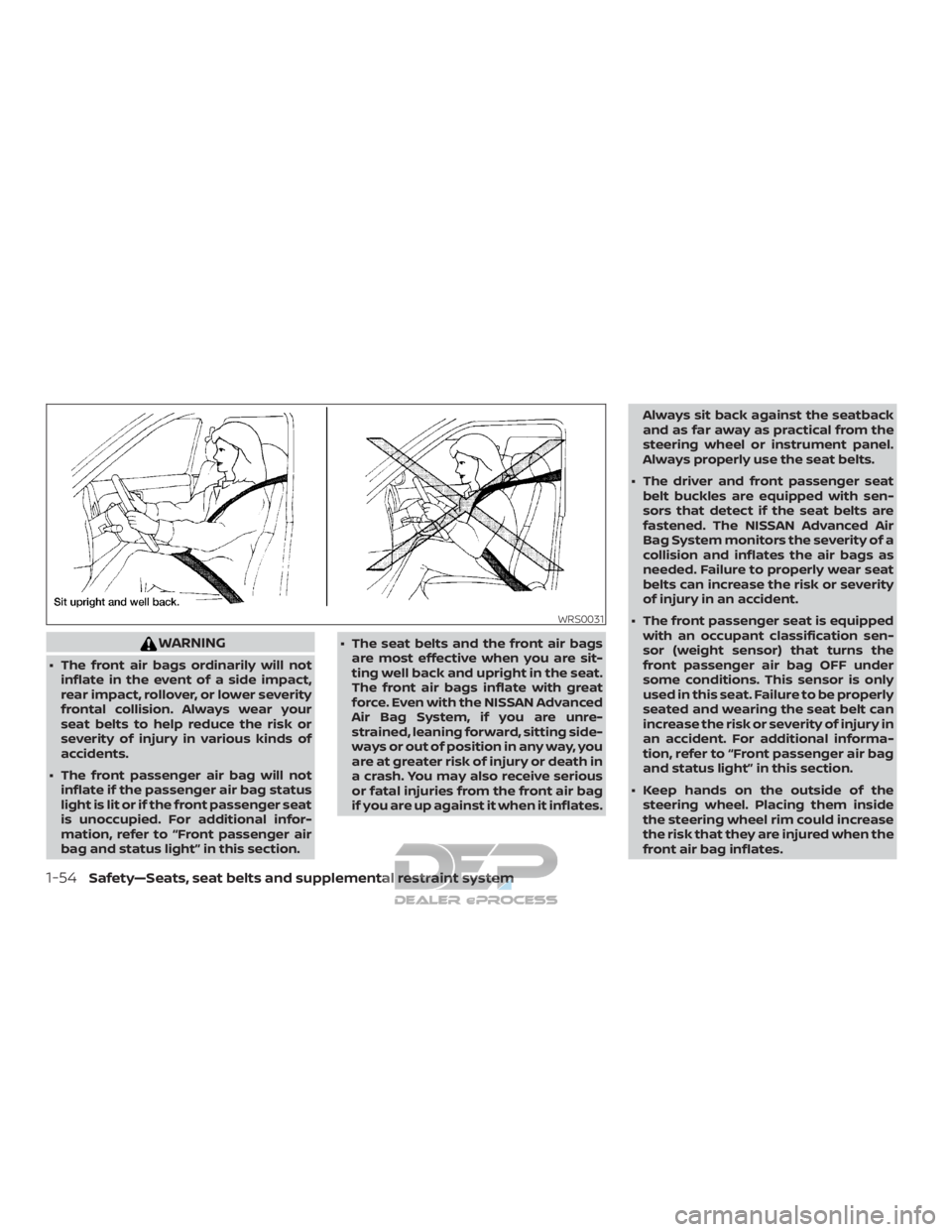
WARNING
∙ The front air bags ordinarily will notinflate in the event of a side impact,
rear impact, rollover, or lower severity
frontal collision. Always wear your
seat belts to help reduce the risk or
severity of injury in various kinds of
accidents.
∙ The front passenger air bag will not inflate if the passenger air bag status
light is lit or if the front passenger seat
is unoccupied. For additional infor-
mation, refer to “Front passenger air
bag and status light” in this section. ∙ The seat belts and the front air bags
are most effective when you are sit-
ting well back and upright in the seat.
The front air bags inflate with great
force. Even with the NISSAN Advanced
Air Bag System, if you are unre-
strained, leaning forward, sitting side-
ways or out of position in any way, you
are at greater risk of injury or death in
a crash. You may also receive serious
or fatal injuries from the front air bag
if you are up against it when it inflates. Always sit back against the seatback
and as far away as practical from the
steering wheel or instrument panel.
Always properly use the seat belts.
∙ The driver and front passenger seat belt buckles are equipped with sen-
sors that detect if the seat belts are
fastened. The NISSAN Advanced Air
Bag System monitors the severity of a
collision and inflates the air bags as
needed. Failure to properly wear seat
belts can increase the risk or severity
of injury in an accident.
∙ The front passenger seat is equipped with an occupant classification sen-
sor (weight sensor) that turns the
front passenger air bag OFF under
some conditions. This sensor is only
used in this seat. Failure to be properly
seated and wearing the seat belt can
increase the risk or severity of injury in
an accident. For additional informa-
tion, refer to “Front passenger air bag
and status light” in this section.
∙ Keep hands on the outside of the steering wheel. Placing them inside
the steering wheel rim could increase
the risk that they are injured when the
front air bag inflates.
WRS0031
1-54Safety—Seats, seat belts and supplemental restraint system
Page 102 of 682
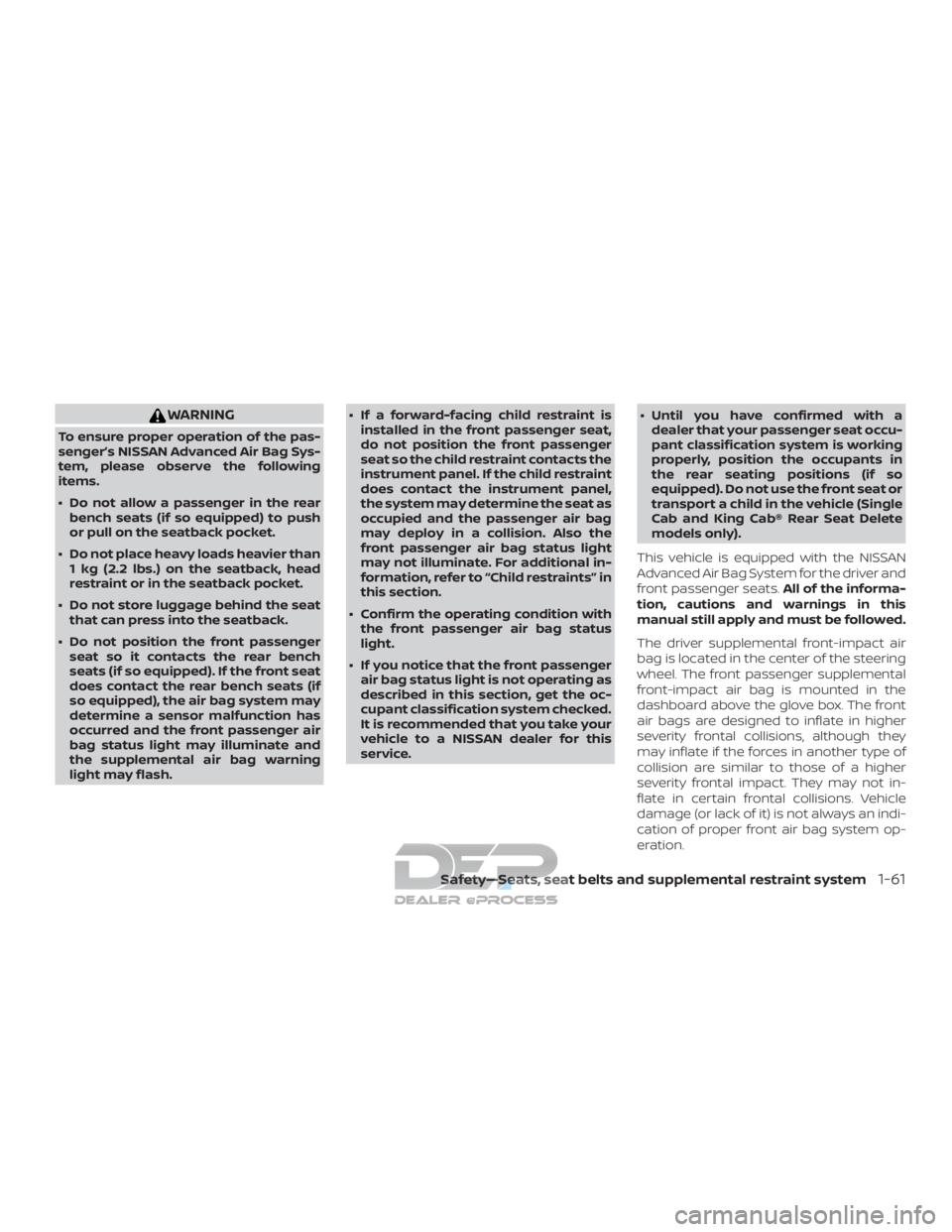
WARNING
To ensure proper operation of the pas-
senger’s NISSAN Advanced Air Bag Sys-
tem, please observe the following
items.
∙ Do not allow a passenger in the rearbench seats (if so equipped) to push
or pull on the seatback pocket.
∙ Do not place heavy loads heavier than 1 kg (2.2 lbs.) on the seatback, head
restraint or in the seatback pocket.
∙ Do not store luggage behind the seat that can press into the seatback.
∙ Do not position the front passenger seat so it contacts the rear bench
seats (if so equipped). If the front seat
does contact the rear bench seats (if
so equipped), the air bag system may
determine a sensor malfunction has
occurred and the front passenger air
bag status light may illuminate and
the supplemental air bag warning
light may flash. ∙ If a forward-facing child restraint is
installed in the front passenger seat,
do not position the front passenger
seat so the child restraint contacts the
instrument panel. If the child restraint
does contact the instrument panel,
the system may determine the seat as
occupied and the passenger air bag
may deploy in a collision. Also the
front passenger air bag status light
may not illuminate. For additional in-
formation, refer to “Child restraints” in
this section.
∙ Confirm the operating condition with the front passenger air bag status
light.
∙ If you notice that the front passenger air bag status light is not operating as
described in this section, get the oc-
cupant classification system checked.
It is recommended that you take your
vehicle to a NISSAN dealer for this
service. ∙ Until you have confirmed with a
dealer that your passenger seat occu-
pant classification system is working
properly, position the occupants in
the rear seating positions (if so
equipped). Do not use the front seat or
transport a child in the vehicle (Single
Cab and King Cab® Rear Seat Delete
models only).
This vehicle is equipped with the NISSAN
Advanced Air Bag System for the driver and
front passenger seats. All of the informa-
tion, cautions and warnings in this
manual still apply and must be followed.
The driver supplemental front-impact air
bag is located in the center of the steering
wheel. The front passenger supplemental
front-impact air bag is mounted in the
dashboard above the glove box. The front
air bags are designed to inflate in higher
severity frontal collisions, although they
may inflate if the forces in another type of
collision are similar to those of a higher
severity frontal impact. They may not in-
flate in certain frontal collisions. Vehicle
damage (or lack of it) is not always an indi-
cation of proper front air bag system op-
eration.
Safety—Seats, seat belts and supplemental restraint system1-61
Page 103 of 682
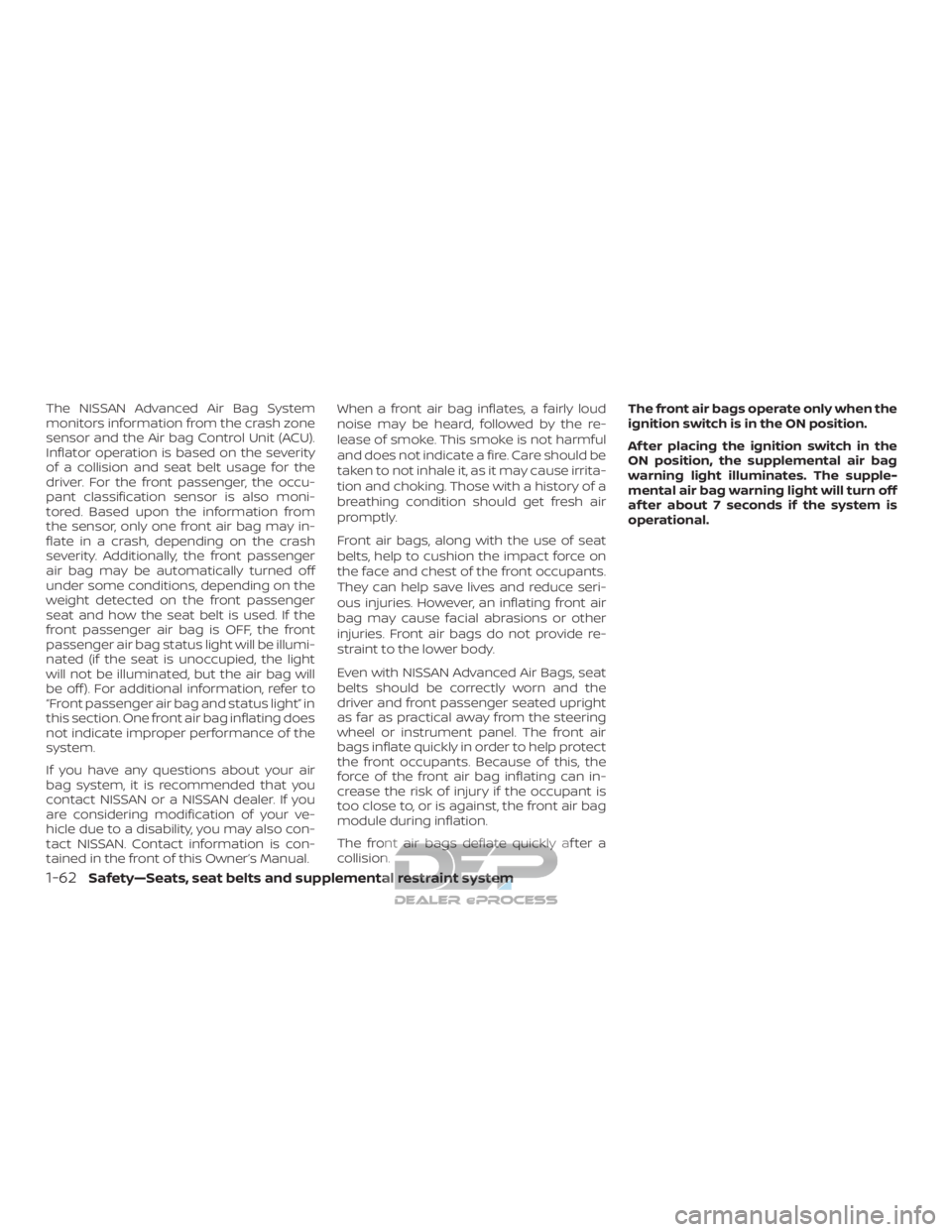
The NISSAN Advanced Air Bag System
monitors information from the crash zone
sensor and the Air bag Control Unit (ACU).
Inflator operation is based on the severity
of a collision and seat belt usage for the
driver. For the front passenger, the occu-
pant classification sensor is also moni-
tored. Based upon the information from
the sensor, only one front air bag may in-
flate in a crash, depending on the crash
severity. Additionally, the front passenger
air bag may be automatically turned off
under some conditions, depending on the
weight detected on the front passenger
seat and how the seat belt is used. If the
front passenger air bag is OFF, the front
passenger air bag status light will be illumi-
nated (if the seat is unoccupied, the light
will not be illuminated, but the air bag will
be off ). For additional information, refer to
“Front passenger air bag and status light” in
this section. One front air bag inflating does
not indicate improper performance of the
system.
If you have any questions about your air
bag system, it is recommended that you
contact NISSAN or a NISSAN dealer. If you
are considering modification of your ve-
hicle due to a disability, you may also con-
tact NISSAN. Contact information is con-
tained in the front of this Owner’s Manual.When a front air bag inflates, a fairly loud
noise may be heard, followed by the re-
lease of smoke. This smoke is not harmful
and does not indicate a fire. Care should be
taken to not inhale it, as it may cause irrita-
tion and choking. Those with a history of a
breathing condition should get fresh air
promptly.
Front air bags, along with the use of seat
belts, help to cushion the impact force on
the face and chest of the front occupants.
They can help save lives and reduce seri-
ous injuries. However, an inflating front air
bag may cause facial abrasions or other
injuries. Front air bags do not provide re-
straint to the lower body.
Even with NISSAN Advanced Air Bags, seat
belts should be correctly worn and the
driver and front passenger seated upright
as far as practical away from the steering
wheel or instrument panel. The front air
bags inflate quickly in order to help protect
the front occupants. Because of this, the
force of the front air bag inflating can in-
crease the risk of injury if the occupant is
too close to, or is against, the front air bag
module during inflation.
The front air bags deflate quickly af ter a
collision.
The front air bags operate only when the
ignition switch is in the ON position.
Af ter placing the ignition switch in the
ON position, the supplemental air bag
warning light illuminates. The supple-
mental air bag warning light will turn off
af ter about 7 seconds if the system is
operational.
1-62Safety—Seats, seat belts and supplemental restraint system
Page 108 of 682
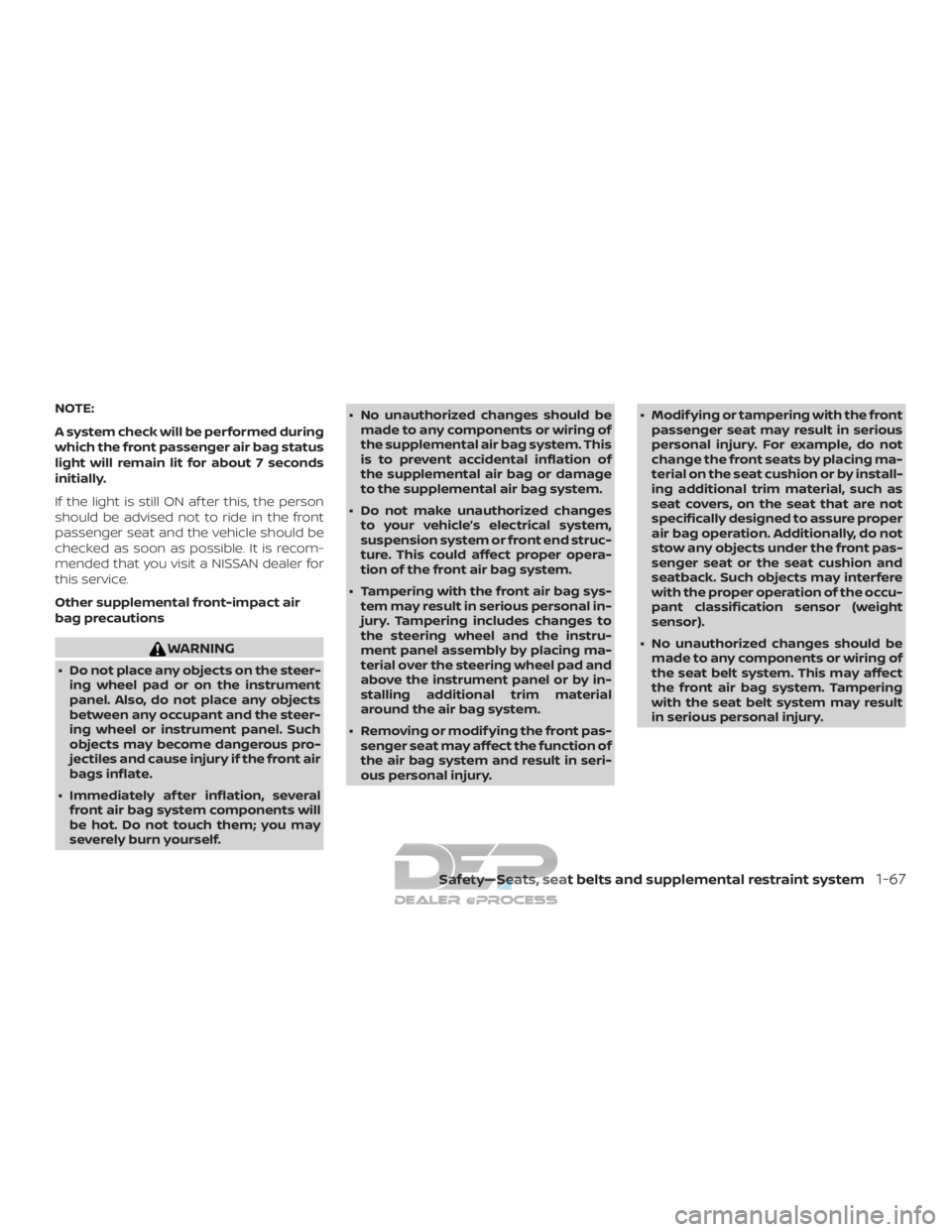
NOTE:
A system check will be performed during
which the front passenger air bag status
light will remain lit for about 7 seconds
initially.
If the light is still ON af ter this, the person
should be advised not to ride in the front
passenger seat and the vehicle should be
checked as soon as possible. It is recom-
mended that you visit a NISSAN dealer for
this service.
Other supplemental front-impact air
bag precautions
WARNING
∙ Do not place any objects on the steer-ing wheel pad or on the instrument
panel. Also, do not place any objects
between any occupant and the steer-
ing wheel or instrument panel. Such
objects may become dangerous pro-
jectiles and cause injury if the front air
bags inflate.
∙ Immediately af ter inflation, several front air bag system components will
be hot. Do not touch them; you may
severely burn yourself. ∙ No unauthorized changes should be
made to any components or wiring of
the supplemental air bag system. This
is to prevent accidental inflation of
the supplemental air bag or damage
to the supplemental air bag system.
∙ Do not make unauthorized changes to your vehicle’s electrical system,
suspension system or front end struc-
ture. This could affect proper opera-
tion of the front air bag system.
∙ Tampering with the front air bag sys- tem may result in serious personal in-
jury. Tampering includes changes to
the steering wheel and the instru-
ment panel assembly by placing ma-
terial over the steering wheel pad and
above the instrument panel or by in-
stalling additional trim material
around the air bag system.
∙ Removing or modif ying the front pas- senger seat may affect the function of
the air bag system and result in seri-
ous personal injury. ∙ Modif ying or tampering with the front
passenger seat may result in serious
personal injury. For example, do not
change the front seats by placing ma-
terial on the seat cushion or by install-
ing additional trim material, such as
seat covers, on the seat that are not
specifically designed to assure proper
air bag operation. Additionally, do not
stow any objects under the front pas-
senger seat or the seat cushion and
seatback. Such objects may interfere
with the proper operation of the occu-
pant classification sensor (weight
sensor).
∙ No unauthorized changes should be made to any components or wiring of
the seat belt system. This may affect
the front air bag system. Tampering
with the seat belt system may result
in serious personal injury.
Safety—Seats, seat belts and supplemental restraint system1-67
Page 109 of 682
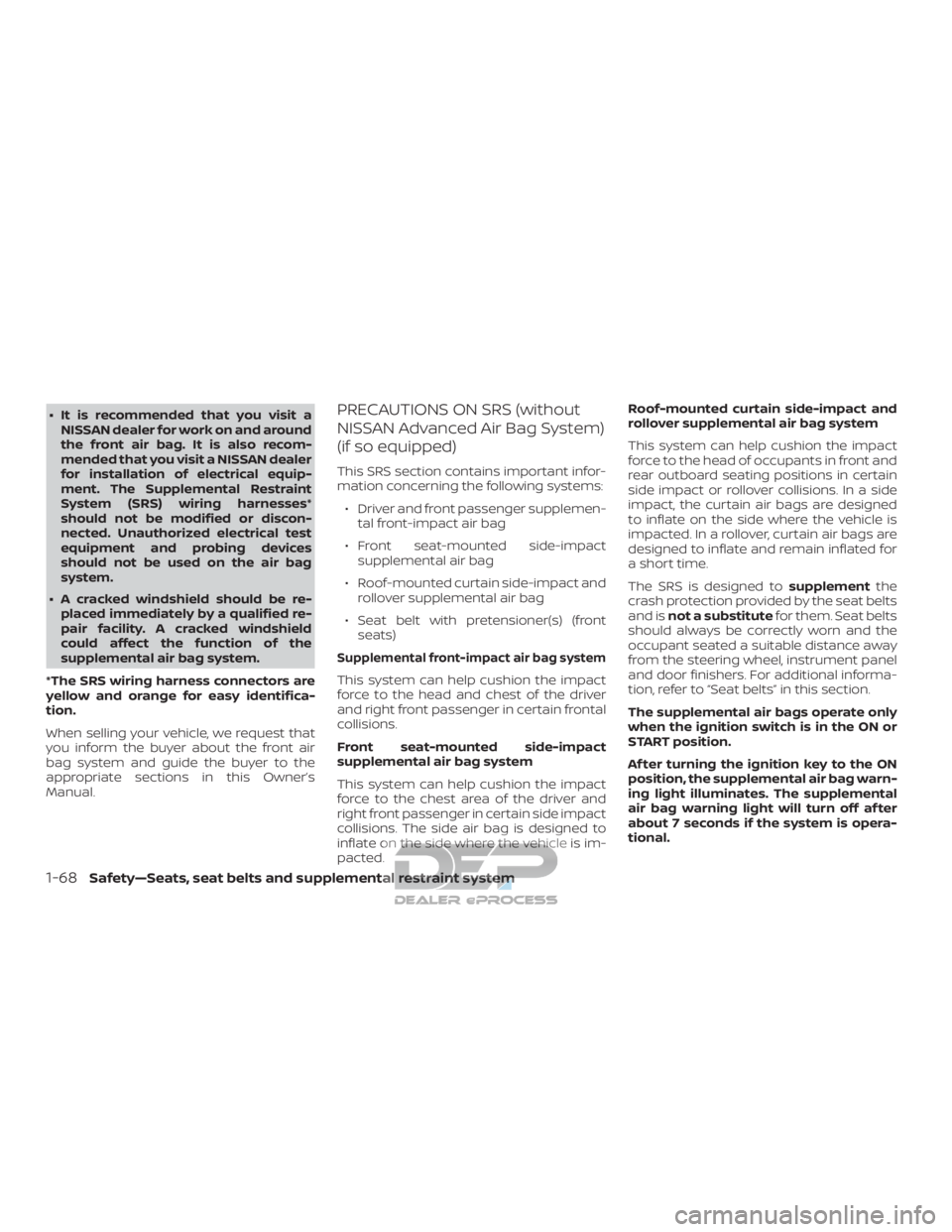
∙ It is recommended that you visit aNISSAN dealer for work on and around
the front air bag. It is also recom-
mended that you visit a NISSAN dealer
for installation of electrical equip-
ment. The Supplemental Restraint
System (SRS) wiring harnesses*
should not be modified or discon-
nected. Unauthorized electrical test
equipment and probing devices
should not be used on the air bag
system.
∙ A cracked windshield should be re- placed immediately by a qualified re-
pair facility. A cracked windshield
could affect the function of the
supplemental air bag system.
*The SRS wiring harness connectors are
yellow and orange for easy identifica-
tion.
When selling your vehicle, we request that
you inform the buyer about the front air
bag system and guide the buyer to the
appropriate sections in this Owner’s
Manual.PRECAUTIONS ON SRS (without
NISSAN Advanced Air Bag System)
(if so equipped)
This SRS section contains important infor-
mation concerning the following systems: ∙ Driver and front passenger supplemen- tal front-impact air bag
∙ Front seat-mounted side-impact supplemental air bag
∙ Roof-mounted curtain side-impact and rollover supplemental air bag
∙ Seat belt with pretensioner(s) (front seats)
Supplemental front-impact air bag system
This system can help cushion the impact
force to the head and chest of the driver
and right front passenger in certain frontal
collisions.
Front seat-mounted side-impact
supplemental air bag system
This system can help cushion the impact
force to the chest area of the driver and
right front passenger in certain side impact
collisions. The side air bag is designed to
inflate on the side where the vehicle is im-
pacted. Roof-mounted curtain side-impact and
rollover supplemental air bag system
This system can help cushion the impact
force to the head of occupants in front and
rear outboard seating positions in certain
side impact or rollover collisions. In a side
impact, the curtain air bags are designed
to inflate on the side where the vehicle is
impacted. In a rollover, curtain air bags are
designed to inflate and remain inflated for
a short time.
The SRS is designed to
supplementthe
crash protection provided by the seat belts
and is not a substitute for them. Seat belts
should always be correctly worn and the
occupant seated a suitable distance away
from the steering wheel, instrument panel
and door finishers. For additional informa-
tion, refer to “Seat belts” in this section.
The supplemental air bags operate only
when the ignition switch is in the ON or
START position.
Af ter turning the ignition key to the ON
position, the supplemental air bag warn-
ing light illuminates. The supplemental
air bag warning light will turn off af ter
about 7 seconds if the system is opera-
tional.
1-68Safety—Seats, seat belts and supplemental restraint system